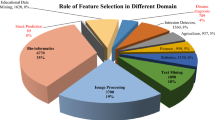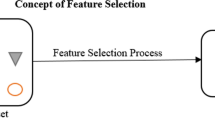Abstract
Web Services act as a backbone to realize the smart city concept. Web service technology is useful to offer various services as part of the smart city. From the smart city perspective, the fundamental problem is selecting the web services offering desired functionality and meeting an end-user’s quality of Service (QoS) expectations. With the rapid increase in the number of web services with similar functionality, the performance of the selection mechanism degrades, and the complexity of the web service selection mechanism increases. A web service selection method is presented in this work, which combines feature selection and QoS-based clustering for an improved web service selection mechanism. The presented method aims to improve the performance and quality of the web service selection mechanism and reduce the complexity. An empirical analysis of the presented method using QoS parameters is performed on the real-world web services QWS dataset, available in the public repository. We compare the performance of the presented method with other state-of-the-art clustering techniques using different evaluation measures based on various performance parameters for the quality of clustering. The experimental results showed that integrating feature selection and QoS-based clustering in the selection mechanism improves the quality of clusters and ultimately improves the performance of the web service selection.




Similar content being viewed by others
Data Availability
The datasets analysed during the current study are available in the QWS data repository, https://qwsdata.github.io/#.
References
Gyrard A, Patel P, Sheth AP, Serrano M (2016) Building the web of knowledge with smart iot applications. IEEE Intell Syst 31(5):83
Natarajan B, Obaidat MS, Sadoun B, Manoharan R, Ramachandran S, Velusamy N (2020) New clustering-based semantic service selection and user preferential model. IEEE Syst J
Mehdi M, Bouguila N, Bentahar J (2014) Probabilistic approach for qos-aware recommender system for trustworthy web service selection. Appl Intell 41(2):503–524
Zou G, Gan Y, Chen Y, Zhang B, Huang R, Xu Y, Xiang Y (2014) Towards automated choreography of web services using planning in large scale service repositories. Appl Intell 41(2):383–404
Kuzu M, Cicekli NK (2012) Dynamic planning approach to automated web service composition. Appl Intell 36(1):1–28
Ghafouri SH, Hashemi SM, Hung PC (2020) A survey on web service qos prediction methods.. IEEE Trans Services Comput
Brock G, Pihur V, Datta S, Datta S et al (2011) Clvalid, an r package for cluster validation. J Stat Softw (Brock et al March 2008)
Shi M, Liu J, Zhou D, Tang M, Cao B (2017) We-lda: a word embeddings augmented lda model for web services clustering. In: 2017 Ieee international conference on web services (icws). IEEE, pp 9–16
Liu J-X, He K-Q, Wang J, Ning D (2011) A clustering method for web service discovery. In: 2011 IEEE international conference on services computing. IEEE, pp 729–730
Pop CB, Chifu VR, Salomie I, Dinsoreanu M, David T, Acretoaie V, Nagy A, Oprisa C (2012) Biologically-inspired clustering of semantic web services. birds or ants intelligence? Concurrency Comput Prac Exp 24(6):619–633
Du YY, Zhang YJ, Zhang XL (2013) A semantic approach of service clustering and web service discovery. Inf Technol J 12(5):967
Wu J, Chen L, Zheng Z, Lyu MR, Wu Z (2014) Clustering web services to facilitate service discovery. Knowl Inform Syst 38(1):207–229
Kotekar S, Kamath SS (2018) Enhancing web service discovery using meta-heuristic cso and pca based clustering. In: Progress in intelligent computing techniques: theory, practice, and applications. Springer, pp 393–403
Kumara BT, Paik I, Siriweera T, Koswatte KR (2017) Qos aware service clustering to bootstrap the web service selection. In: 2017 IEEE international conference on services computing (SCC). IEEE, pp 233–240
Rupasingha RA, Paik I (2018) Improving service recommendation by alleviating the sparsity with a novel ontology-based clustering. In: 2018 IEEE international conference on web services (ICWS). IEEE, pp 351–354
Bravo M, Mora-Gutiérrez RA, Hoyos-Reyes LF (2019) Bio-inspired hybrid algorithm for web services clustering. In: Advanced analytics and artificial intelligence applications. IntechOpen
Zou G, Qin Z, He Q, Wang P, Zhang B, Gan Y (2019) Deepwsc: a novel framework with deep neural network for web service clustering. In: 2019 IEEE international conference on web services (ICWS). IEEE, pp 434–436
Agarwal N, Sikka G, Awasthi LK (2020) Evaluation of web service clustering using dirichlet multinomial mixture model based approach for dimensionality reduction in service representation . Inform Process Manag 57(4):102238
Weerasinghe AM, Rupasingha RA (2021) Improving web service recommendation using clustering with k-nn and svd algorithms. KSII Trans Int Inform Syst 15(5):1708–1727
Hu Q, Shen J, Wang K, Du J, Du Y (2022) A web service clustering method based on topic enhanced gibbs sampling algorithm for the dirichlet multinomial mixture model and service collaboration graph. Inf Sci 586:239–260
Wu J, Chen L, Zheng Z, Lyu MR, Wu Z (2014) Clustering web services to facilitate service discovery. Knowl Inform Syst 38(1):207–229
Johnstone IM, Lu AY (2009) Sparse principal components analysis. arXiv:0901.4392
SG R, Chakrabarti A (2017) A novel graph clustering algorithm based on discrete-time quantum random walk. In: Quantum inspired computational intelligence. Elsevier, pp 361–389
Al-Masri E, Mahmoud QH (2009) Web service discovery and client goals. Computer 42 (1):104–107
Kang G, Liu J, Tang M, Cao B (2013) Web service selection algorithm based on principal component analysis. J Electr (China) 30(2):204–212
Ringnér M (2008) What is principal component analysis? Nature Biotechnology 26(3):303–304
Alkaya A, Eker İlyas (2011) Variance sensitive adaptive threshold-based pca method for fault detection with experimental application. ISA Trans 50(2):287–302
Cleophas TJ, Zwinderman AH (2016) Non-parametric tests for three or more samples (friedman and kruskal-wallis). In: Clinical data analysis on a pocket calculator. Springer, pp 193–197
Gignac GE, Szodorai ET (2016) Effect size guidelines for individual differences researchers. Pers Individ Differ 102:74–78
Yahyaoui H, Own HS (2018) Unsupervised clustering of service performance behaviors. Inf Sci 422:558–571
Messiaid A, Mokhati F, Benaboud R, Salem H (2021) Towards dynamic reconfiguration of a composite web service: an approach based on qos prediction. Electronics 10(13):1597
Ratnakar A, Sharma P, Gupta S, Purohit L (2019) Web service clustering on the basis of qos parameters. In: 2019 1st International conference on artificial intelligence and data sciences (AiDAS). IEEE, pp 12–17
Silva LDJ, Claro DB, Pav D, Lopes A (2015) Semantic-based clustering of web services. J Web Eng:325–345
Zheng K, Xiong H, Cui Y, Chen J, Han L (2012) User clustering-based web service discovery. In: 2012 Sixth international conference on internet computing for science and engineering. IEEE, pp 276–279
Ismaili F (2012) Hybrid web service selection by combining semantic and keyword approaches. In: Recent progress in data engineering and internet technology. Springer, pp 31–38
Tripathy AK, Patra MR, Khan MA, Fatima H, Swain P (2014) Dynamic web service composition with qos clustering. In: 2014 IEEE international conference on web services. IEEE, pp 678–679
Zhang X, Wang Z, Lv X, Qi R (2013) A clustering-based qos prediction approach for web service selection. In: 2013 International conference on information science and cloud computing companion. IEEE, pp 201–206
Yi X, Chen P, Bao L, Wang M (2011) Jing Yang. A qos-aware web service selection algorithm based on clustering. In: 2011 IEEE international conference on web services. IEEE, pp 428–435
Mobedpour D, Ding C (2013) User-centered design of a qos-based web service selection system. SOCA 7(2):117–127
Yujian Li , Liye X (2010) Unweighted multiple group method with arithmetic mean. In: 2010 IEEE fifth international conference on bio-inspired computing: theories and applications (BIC-TA). IEEE, pp 830–834
Wehrens R, Kruisselbrink J (2018) Flexible self-organizing maps in kohonen 3.0. J Stat Softw 87(1):1–18
Andrews JL, Wickins JR, Boers NM, teigen PDM (2018) An r package for model-based clustering and classification via the multivariate t distribution. J Stat Softw 83(7):1–32
Yang M-S, Nataliani Y (2017) A feature-reduction fuzzy clustering algorithm based on feature-weighted entropy. IEEE Trans Fuzzy Syst 26(2):817–835
Acknowledgements
The authors are very grateful to the editor and reviewers to provide the valuable insight and remarks, which aided in the advancement of the manuscript.
Author information
Authors and Affiliations
Corresponding author
Additional information
Publisher’s note
Springer Nature remains neutral with regard to jurisdictional claims in published maps and institutional affiliations.
Appendix: A
Appendix: A
This section describes different performance measures that have been used to evaluate the quality of the service clusters (Given in Table 13). Furthermore, this section provides details of the used clustering techniques (Given in Table 14).
We have used R programming environment packages to implement PCA and the used clustering techniques. prcomp() package is used to implement principal component analysis and clvalid() package is used to implement and validate clustering techniques. The used parameter details of these techniques are given in Table 15).
Rights and permissions
Springer Nature or its licensor holds exclusive rights to this article under a publishing agreement with the author(s) or other rightsholder(s); author self-archiving of the accepted manuscript version of this article is solely governed by the terms of such publishing agreement and applicable law.
About this article
Cite this article
Purohit, L., Rathore, S.S. & Kumar, S. Feature selection and clustering based web service selection using QoSs. Appl Intell 53, 13352–13377 (2023). https://doi.org/10.1007/s10489-022-04042-w
Accepted:
Published:
Issue Date:
DOI: https://doi.org/10.1007/s10489-022-04042-w




